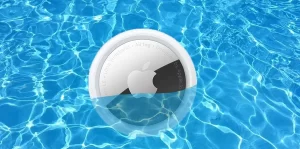Airtags, Apple’s innovative tracking devices, have gained popularity for their ability to help users locate misplaced items using the Find My app. However, a common concern among users is whether Airtags can withstand exposure to water. In this introduction, we explore the implications of getting Airtags wet.
Airtags, like many electronic devices, are not explicitly designed to be waterproof. While they may be resilient to minor splashes or incidental exposure to moisture during everyday use, prolonged or excessive contact with water can compromise their functionality and durability. Water damage can affect the internal components of the Airtag, leading to issues such as corrosion, electrical shorts, and malfunctions.

Understanding the limitations of Airtags in wet environments is essential for users looking to maximize the lifespan and performance of their devices. By taking proactive measures to protect Airtags from water exposure, such as keeping them in waterproof cases or avoiding immersion in liquids, users can mitigate the risk of damage and ensure the continued effectiveness of their tracking capabilities.
In this exploration of Airtag durability, we delve into the factors that contribute to water resistance, the potential consequences of water damage, and practical tips for safeguarding Airtags in various environments. By gaining insight into the capabilities and limitations of Airtags in wet conditions, users can make informed decisions to protect their investment and enhance their tracking experience.
Can Airtags Get Wet Is It Waterproof?
AirTags come equipped with a battery cover that provides them with an IP67 rating, indicating a certain level of water resistance. In practical terms, this means that AirTags can withstand most splashes and can even be submerged in water up to a depth of one meter (approximately 3.3 feet) for a duration of up to 30 minutes. Therefore, if you accidentally expose an AirTag to water, such as leaving it in the shower or dropping it in a toilet, it is likely to remain functional.

However, it’s important to note that this rating is achieved under controlled laboratory conditions. While an AirTag may survive incidental exposure to water in everyday scenarios, engaging in activities like swimming or taking regular showers with an AirTag is not advisable. Deliberately submerging an AirTag in a pond or bathtub with the intention of causing damage may eventually lead to its deterioration, even though it might take longer than the specified 30-minute limit.
Apple itself advises that water resistance is not a permanent condition and may diminish over time due to normal wear and tear. Consequently, subjecting an AirTag to rough treatment, such as tossing it into a luggage bag, hiking pack, or gym bag, may accelerate the deterioration of its water resistance. To preserve the longevity of an AirTag’s water resistance, it is advisable to handle it with care and avoid subjecting it to unnecessary stress or rough handling.
Read Also:- Add Safari To Home Screen On Your Iphone And Ipad
How To Dry Your AirTags
If an AirTag comes into contact with water, the first step to mitigate potential damage is to gently dry the exterior using a soft cloth. This helps prevent the liquid from seeping into the device and compromising its sealing. It’s important to avoid using a blow dryer, as the heat generated could potentially harm the sealing or internal circuitry of the AirTag.

However, if there is concern that water has penetrated past the sealing, further steps may be necessary:
1. Remove the battery cover by pressing it down and rotating it counterclockwise until it stops. This disassembles the cover, body, and battery of the AirTag.
2. Separate the components and allow them to air-dry for several hours. While silica packs may help accelerate the drying process, it is advisable to avoid using rice, as grain fragments could become lodged inside the device.
3. Once the components are thoroughly dried, reassemble the AirTag. It’s important to ensure that a tone is heard when the battery is pressed into its slot during reassembly. This indicates that the battery is properly connected, which is a positive sign that the AirTag is still functional.
To verify the functionality of the AirTag, open the Find My app on your iPhone or iPad and select the AirTag in the Items tab. If the AirTag is functioning properly, it’s advisable to avoid exposing it to water in the future to prevent any potential damage or deterioration.
Conclusion
While Airtags have a degree of water resistance, they are not entirely waterproof. With an IP67 rating, they can withstand splashes and brief submersion in water of up to one meter for 30 minutes under ideal laboratory conditions. However, deliberate or prolonged exposure to water can compromise their functionality over time.
If an Airtag does get wet, immediate action can help minimize potential damage. Drying the exterior with a soft cloth is the first step, but caution must be taken not to use a blow dryer, as heat can harm the device. If water has penetrated past the sealing, disassembling the Airtag and allowing its components to air-dry thoroughly is recommended. Reassembling the device carefully and ensuring that the battery is properly connected is essential.
